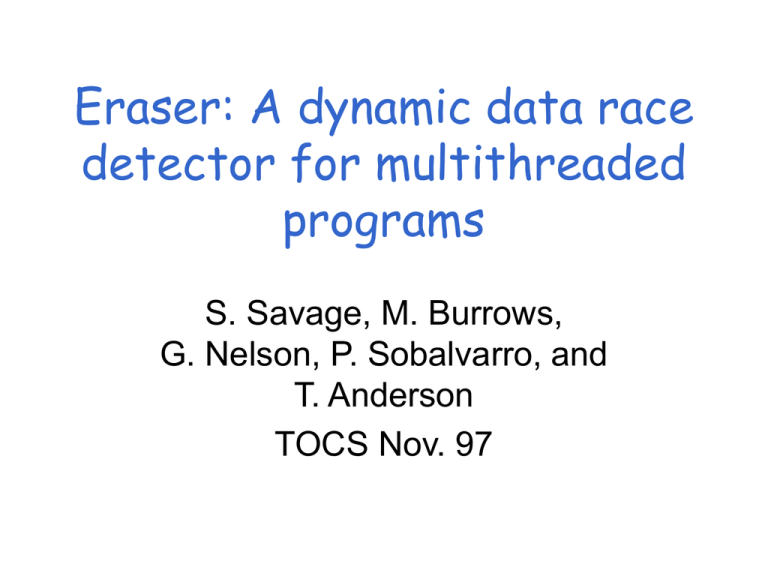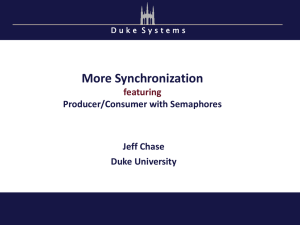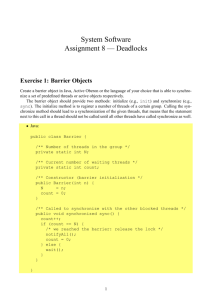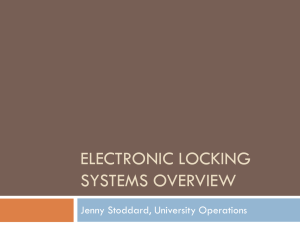ppt
advertisement

Eraser: A dynamic data race
detector for multithreaded
programs
S. Savage, M. Burrows,
G. Nelson, P. Sobalvarro, and
T. Anderson
TOCS Nov. 97
Overview
• Dynamic data race detection tool – testing
paradigm instead of static analysis.
• Checks that each shared memory access follows
a consistent locking discipline
• Data race – when 2 concurrent threads access a
shared variable and at least one is a write and
the threads use no explicit synchronization to
prevent simultaneous access.
– Effect will depend on interleaving
Previous Approaches:
Lamport’s Happened-Before
lock(mutex)
Previous work
• If 2 threads access
a shared variable v = v+1;
and the accesses
are not ordered by unlock(mutex)
happens-before
then potential race.
lock(mutex)
v = v+1;
unlock(mutex)
Drawbacks of Happened-Before
• Difficult to implement efficiently –
need per-thread information about access
ordering to all shared memory locations.
• Highly dependent on scheduler – needs
large number of test cases.
y=y+1;
lock(mutex)
Previous work
• If 2 threads access
v = v+1;
a shared variable
and the accesses
are not ordered by unlock(mutex)
happens-before
then potential race.
• Depends on
scheduler
lock(mutex)
v = v+1;
unlock(mutex)
y=y+1;
lock(mutex)
Previous work
• If 2 threads access
a shared variable
and the accesses
are not ordered by y=y+1;
happens-before
lock(mutex)
then potential race.
• Depends on
v = v+1;
scheduler
unlock(mutex)
v = v+1;
unlock(mutex)
y=y+1;
Idea in Eraser
• Checks that locking discipline is observed.
– That the same lock(s) is held whenever the
shared data object is accessed.
– Infer which locks protect which data items
Lockset Algorithm
• C(v) – candidate locks
for v
• locks-held(t) – set of
locks held by thread t
• Lock refinement
for each v, init C(v) to set
of all locks
On each access to v by
thread t:
C(v) = C(v) 3 locksheld(t)
If C(v) = {} issue warning
Example
lock(mu1)
v=v+1
unlock(mu1)
lock(mu2)
v=v+1
unlock(mu2)
locks-held
{}
{mu1}
C(v)
{mu1, mu2}
{mu1}
{}
{mu2}
{}
{}
More Sophistication
• Initialization without
locks
• Read-shared data
(written only during init,
read-only afterwards)
• Reader-writer locking
(multiple readers)
Don’t start until see a
second thread
Report only after it
becomes write shared
Change algorithm to
reflect lock types
On read of v by t:
C(v) = C(v) 3
locks-held(t)
On write of v by t:
• False Alarms still
possible
C(v) = C(v) 3
held(t)
write-locks-
Per-Location State
virgin
C(v) updated,
races reported
wr, 1st thread
wr, new thread
rd, wr,
1st thread
exclusive
Shared
modified
wr
rd, new thread
shared
C(v) updated,
no race reporting
Implementation
• Binary rewriting used
– Add instrumentation to call Eraser runtime
– Each load and store updates C(v)
– Each Acquire and Release call updates
locks-held(t)
– Calls to storage allocator initializes C(v)
• Storage explosion handled by table lookup and
use of indexes to represent sets
– Shadow word holds index number
• Slowdown by factor of 10 to 30x
– Will change interleavings
Shadow Memory and Lockset Indexes
Common False Alarms Annotations
• Memory reuse
• Private locks
• Benign races
if (some_condition) {
LOCK m DO
if (some_condition)
{stuff}
END
}
EraseReuse – resets
shadow word to virgin
state
Lock annotations
EraserIgnoreOn()
EraserIgnoreOff()
Races inside OS
• Using interrupt system to provide mutual
exclusion – this implicitly locks everything
affected (by interrupt level specified)
– Explicitly associate a lock with interrupt level –
disabling interrupt is like acquiring that lock
• Signal and wait kind of synchronization
– V to signal for P which waits -- semaphore not
“held” by thread.
An OK Race in AltaVista
Bad Race in Vesta
Core Loop of Lock-Coupling
// ptr->lock.Acquire(); has been done before loop
while (next != null & key > next->data)
{next->lock.Acquire();
ptr->lock.Release();
ptr=next;
next=ptr->next;
}
2
4
ptr
next
6
8
null











